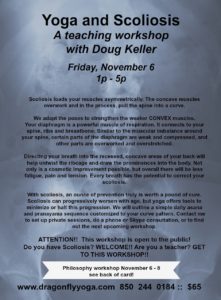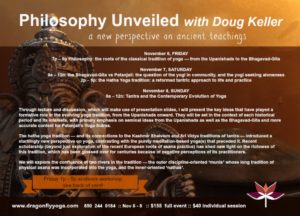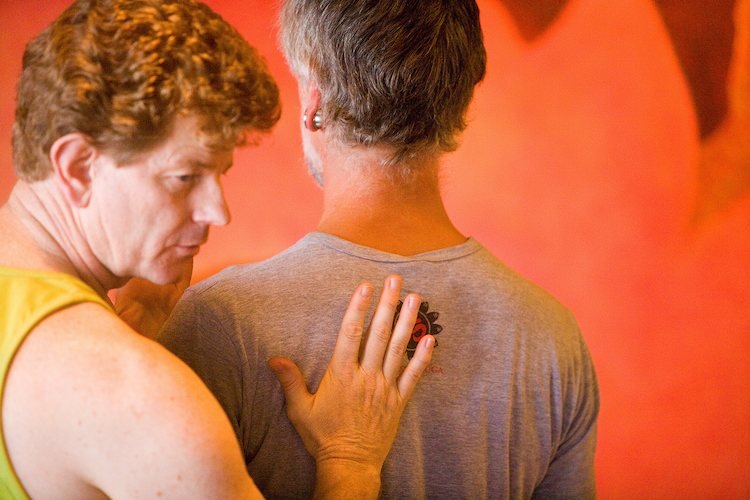Doug Keller Yoga Teacher Training & Workshops
November 2015 at Dragonfly Yoga
Click Here > To Sign Up
Doug Keller trains yoga teachers world-wide, setting forth a new paradigm for training, particularly in the area of therapeutics and healing. Doug offers solid teaching and insight into the anatomy and workings of the human body in relation to yoga, and into the possibilities for healing through yoga. Dragonfly Yoga is honored to host Doug for special teacher training workshop and classes
 Doug Keller Yoga Training Retreat
Doug Keller Yoga Training Retreat
November 6 – 8
Open to the public and all styles of yoga teaching and teacher training
FRIDAY
- 1p – 5p Scoliosis Workshop
- 7p – 9 Philosophy: the roots of the classical tradition of yoga — from the Upanishads to the Bhagavad-Gita
SATURDAY
- 9a – 12n: the Bhagavad-Gita vs Patanjali: the question of the yogi in community, and the yogi seeking aloneness
- 2p – 5p: the Hatha Yoga tradition: a reformed tantric approach to life and practice
SUNDAY
- 9a – 12n: Tantra and the Contemporary Evolution of Yoga
Classical Tradition:
Through lecture and discussion, which will make use of presentation slides, I will present the key ideas that have played a formative role in the evolving yoga tradition, from the Upanishads onward. They will be set in the context of each historical period and its interests, with primary emphasis on seminal ideas from the Upanishads as well as the Bhagavad-Gita and more accurate context for Patanjali’s Yoga Sutras. But the main emphasis will be on the contributions of the hatha yoga and tantra traditions, and their relevance to how we practice today. Included will be a consideration of the evolution of Modern Yoga, from the 19th century onward. This will not simply be an historical presentation: we will be contemplating the role and relevance of these inspirations in our own practice and life.
What are the learning objectives of the class?
A grasp of and ability to verbalize and discuss the primary ideas of the yoga tradition, as well as a clear grasp of their historical context and original meaning and relevance to the concerns of the time in which they arose. This includes a grasp of the concepts and goals of yoga practice, including those of the Modern era. Overall, we will seek a grasp of the richness and variety of the tradition(s) of yoga, from which we can draw inspiration for our own practice.
New Light on the Hatha Yoga Tradition
The hatha yoga tradition — and its connections to the Kashmir Shaivism and Sri Vidya traditions of tantra — introduced a startlingly new perspective on yoga, contrasting with the purely meditation-based yoga(s) that preceded it. Recent scholarship (beyond just exploration of the recent European roots of asana practice) has shed new light on the richness of this tradition, which has been glossed over for centuries because of negative perceptions of its practitioners.
We will explore the confluence of two rivers in the tradition — the outer discipline-oriented ‘munis’ whose long tradition of physical asana was incorporated into the yoga, and the inner-oriented ‘nathas’ (from Gorakshanatha, the founder) onward, whose reform of the tantra of the time brought laya yoga as well as emerging concepts such as the granthis and chakras into the mix. How this relationship is expressed in the main texts (Hatha Yoga Pradipika, Gheranda Samhita and Shiva Samhita) will be explored, as well as the role of the earlier texts in setting up the new paradigm. This relationship concerns how ‘hatha’ and ‘laya’ (and other forms of practice) are brought together in relation to ‘raja’ yoga, and what practices these entail. We will also look at how hatha yoga changes over the centuries from a purely tantric practice to a Vedantic perspective — and what that came to mean in practice.
This discussion promises to be enlightening and inspiring, as well as equipping one to better discuss the roots of yoga as we practice it — particularly in relation to modern debates of the Hindu ‘ownership’ of yoga as rooted in the Vedas. We will look at how many of the terms and concepts of hatha yoga were appropriated in the last couple of centuries, while the ‘tantric’ and physical aspects of the practice were denigrated in favor of Patanjali Yoga; and how the very concept of ‘Raja’ yoga was transformed to suit modern prejudices.
The end result of the historical process is a lot of confusion for modern practitioners — a confusion that we can now begin to untangle. There is much within hatha yoga to be explored from a contemporary perspective on body, mind and emotion which is just waiting to be unfolded!
TO SIGN UP:
Those interested in attending can sign up for the full teacher training, the full weekend, or individual sessions for the weekend.
Click Here > To Sign Up
Doug Keller Bio:
Doug Keller, ERYT500
Education:
I came to teach hatha yoga by way of the yoga of meditation and years of academic study of philosophy, both eastern and western. In my studies of philosophy at the School of Foreign Service at Georgetown and in my graduate work at Fordham University, I gravitated toward the senior Jesuit scholars whose excellence, openminded intellectual zeal, spiritual fervor and personal integrity inspired me to dig deeply into my own studies, particularly of the classical philosophers and Christian mystics, and treat them as a personal journey of discovery.
As I completed my coursework for my PhD and taught at several colleges, I was increasingly aware that I was looking for more than philosophical ideas and systems — I was looking for the experience itself that the mystics were talking about.
At the time I was finishing my coursework, I met the meditation master Swami Muktananda during his last tour of the west, and he gave me the connection, the practice, the awakening and the understanding I was seeking. With that, it was up to me to step through the door he had opened, not through concepts and theories, but through yoga.
I halted my academic career just short of writing my thesis, and went to India in 1986 to practice yoga at his ashram and to offer my service. I spent a total of 7 years in the Ganeshpuri ashram, Gurudev Siddha Peeth, and 14 years of service overall in Siddha Yoga ashrams in the US and abroad, studying and practicing yoga, working in the kitchen and gardens, and teaching hatha yoga.
It was during my time in Ganeshpuri that I met John Friend while he was yet an Iyengar teacher who had come to study in Pune. We struck up a friendship and I was able to practice with him when I came back to the states, study further with him, and assist in his classes, workshops and trainings for the next few years.
Yoga:
The time of my growth in the practice of hatha yoga was divided between individual practice at the ashram in India, and opportunities to study with teachers and expand during time spent at the ashram in New York state. There I was able to study with other teachers and in a number of styles — but principally with Kevin Gardiner, who is a certified senior level Iyengar teacher.
Kevin was the most influential to me in my growth, because of his deep insight into anatomy and physiology, his facility with precise instruction and demonstration, and the integrity with which he stays true to his chosen tradition, exploring its depth while exercising his own very individual and discriminating intellect, manifesting the heart of a yogi in his practice and teaching.
Yet because my own path was more closely tied to Siddha Yoga at the time, I was more deeply involved in the development of the Anusara system. John Friend shared with me the evolution of his thinking based principally upon the alignment teachings of the Iyengar system, and his synthesis of those teachings eventually manifested as the Anusara style of yoga he founded in 1997.
I was one of the first teachers certified as an Anusara teacher by John Friend, and taught in the Anusara style for over 7 years. At his suggestion, early on I wrote Anusara Yoga: Hatha Yoga in the Anusara Style, and continued to develop that book until Mr. Friend chose to consolidate his authority over the system and discouraged its further use among teachers seeking certification in his style.
Eventually I was forced to give up my certification in that style, which freed me to further deepen my study and understanding of the therapeutic aspects of yoga as well as well as explore the yoga tradition as a whole outside of the confines of the Anusara system.
Vision:
In addition to teaching the postural practice of hatha yoga as well as pranayama and meditation, I have chosen as my focus the realm of Yoga as Therapy, which is an evolving field that promises to be a vital part of the future of yoga.
The expansion of yoga beyond the practices taught in more ancient times is, to me, an expression of the freedom at the heart of yoga and of consciousness itself. This freedom was described in tantric philosophy as not simply ‘liberation’ or ‘moksha,’ but ‘Swatantrya’ — the freedom of Consciousness to expand and create through its own inspiration. Yoga as an expression of this is not bound to antiquity, but inherently contains the inspiration to evolve for the sake of the good.
I found the essence of this inspiration to be expressed by Swami Muktananda, who first initiated my journey into yoga: ‘God dwells within you, as you, for you. See God in yourself and in each other.’ All knowledge and experience is illuminated by that presence and source of inspiration.
I choose the word ‘Swatantrya,’ the yoga of one’s own inner expansion and awakening, not to establish yet another ‘style’ of yoga, but to express the essence and character of what yoga promises to be.
Yoga concerns our own relationship to the Self from whom we came. It is deeply personal, experiential, and ultimately unmediated by any system of conceptual thought. The teachings of yoga simply provide us with the introduction to our own Self.
Philosophy provides the contemplation and focus that help us to aim more deeply into the experience.
In the end, the ‘breakthrough’ we experience is what the Christian mystic Meister Eckhart described as the breakthrough into our own heart, where the Divine most fully dwells. This is the teaching I want to share, along with the practices and means offered by yoga to support that inward journey.
I travel nationally and internationally offering workshops and teacher trainings. I’ve traveled from one end of the United States to the other, and my international travels have included teacher trainings in Europe as well as Asia. My home base is at the Health Advantage Yoga Center in Herndon, Virginia, near Dulles outside of Washington D.C., where I teach upper level classes.
